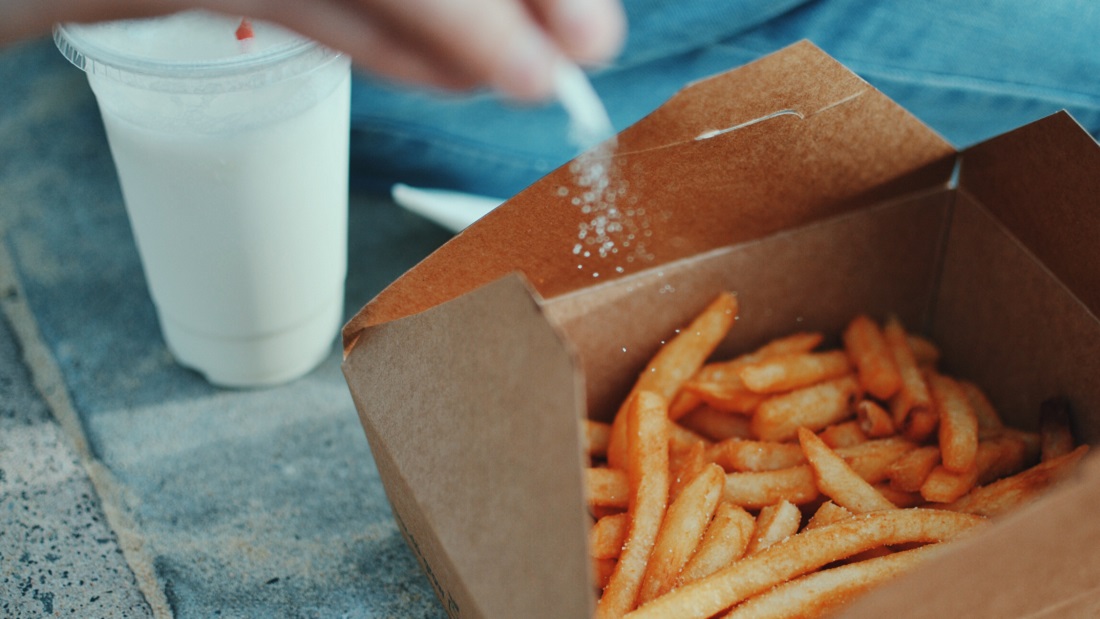Sodium

A diet high in salt (or sodium) can increase your blood pressure, which can increase your risk of heart disease and stroke.
How much do you need daily?
Adults should eat no more than 6.0 grams of salt (2.4 grams of sodium) per day, which is around one teaspoon.
Salt is also called ‘sodium chloride’ and it contains the mineral sodium. By weight, table salt and most sea salts contain about 40 per cent sodium. Sometimes, food labels only give the figure for sodium. The NHS provides a simple way to work out how much salt you are eating from the sodium figure:
Salt = sodium x 2.5
So, if the label only lists sodium, you can work out the amount of salt in it by multiplying the total sodium by 2.5. For example, one gram of sodium per 100 grams is 2.5 grams of salt per 100 grams.
The government recommends the following intakes
| Age | Amount of sodium recommended (grams per day) |
|---|---|
| 0-3 months | 0.21 |
| 4-6 months | 0.28 |
| 7-9 months | 0.32 |
| 10-12 months | 0.35 |
| 1-3 years | 0.50 |
| 4-6 years | 0.70 |
| 7-10 years | 1.20 |
| Males | |
| 11+ years | 1.60 |
| Females | |
| 11+ years | 1.60 |
| During pregnancy | No increase required |
| Breastfeeding | No increase required |
The maximum amount of salt you should have depends on your age:
| Age | Maximum amount of salt per day (grams) | Maximum amount of sodium per day (grams) |
|---|---|---|
| 1-3 years | 2.0 | 0.8 |
| 4-6 years | 3.0 | 1.2 |
| 7-10 years | 5.0 | 2.0 |
| 11+ years | 6.0 | 2.4 |
Are we getting enough?
On average, people in the UK eat eight grams of salt (about 3.2 grams of sodium) a day, which is much more than the body needs.
Why do we need it??
We need small amounts of sodium so our bodies can conduct nerve impulses, contract and relax muscles and maintain the right balance of water and minerals in body fluids. It’s essential to good health but we tend to have too much of it. That’s because we get a plentiful supply of sodium in salt – sodium chloride.
Too much sodium in the diet can lead to high blood pressure, heart disease and stroke. Salt not only adds flavour to food but is also used as a preservative, binder and stabiliser so it’s widely used even in products you might not expect to find salt in. In fact, the biggest culprit for adding salt to the diet of children and teenagers in the UK is pizza. Salt is also used in chicken to absorb water (to increase the weight and profitability).
If you consistently eat excessive amounts of salt, this can result in sodium toxicity with symptoms including swelling of the hands and feet and excess calcium lost in the urine – this in turn can increase risk of osteoporosis and high blood pressure. Salt directly damages blood vessels within 30 minutes of eating it. But it also raises blood pressure by making you hold on to water in your bloodstream.
Lack of sodium usually occurs in situations when you have extreme sodium losses through prolonged sweating (physical exertion, working in hot conditions) or due to an illness causing vomiting and diarrhoea or a chronic condition (kidney disease).
Do I need a supplement?
No, a healthy vegan diet will cover your needs.
The best plant sources
Salt is found in many foods, including cereal products (breakfast cereals and wholegrain products). Processed foods can contain relatively high levels.
Signs of deficiency
Headache, confusion, nausea and vomiting, tiredness, muscle spasms or cramps and seizures.
Foods to include
Foods to watch!

The sodium or salt content of food is very variable, but in general these foods can contain high levels: olives, pickles, soya sauce, stock cubes, yeast extract, pasta sauces, crisps, pizza, ready meals, soup, sandwiches, veggie sausages, tomato ketchup, mayonnaise and other sauces.
Foods such as breakfast cereals and bread products (bread products such as crumpets, bagels and ciabatta) can contribute a lot of salt to our diet, not because these foods are always high in salt, but because we eat a lot of them.
Tips to reduce your salt intake:
- Check nutrition labels on food and choose foods with less salt or low-salt versions
- Eat fewer salty snacks (crisps and salted nuts)
- Choose tinned vegetables and pulses with no added salt
- Use herbs and spices for flavour when cooking instead of salt
- Choose low-salt stock cubes, or make homemade stock without salt
- Taste your food first and don’t automatically add extra salt at the table
- Use soya sauce, brown sauce, ketchup and mayonnaise sparingly, as these are often high in salt
Additional information
Babies
Babies should not be given too much salt because their immature kidneys are not able to process it. Babies under one year old should have less than one gram of salt a day. Breastfed infants will get the right amount of minerals from breast milk. Formula milk contains a similar amount of minerals to breast milk.
Don’t add salt to your baby’s milk or food and avoid using stock cubes, gravy, processed foods and ready meals as they’re often high in salt. Food made specifically for babies should meet the recommended levels. If in doubt, always check the nutrition label.
Soluble vitamin supplements and painkillers
The NHS warn that if you routinely take effervescent (dissolvable) vitamin supplements or painkillers, it’s worth remembering that these can contain up to one gram of salt per tablet. You may want to consider changing to a non-effervescent tablet, especially if you have been advised to reduce your salt intake.
This post has been categorised in: A-Z of nutrients, A-Zs, Health




